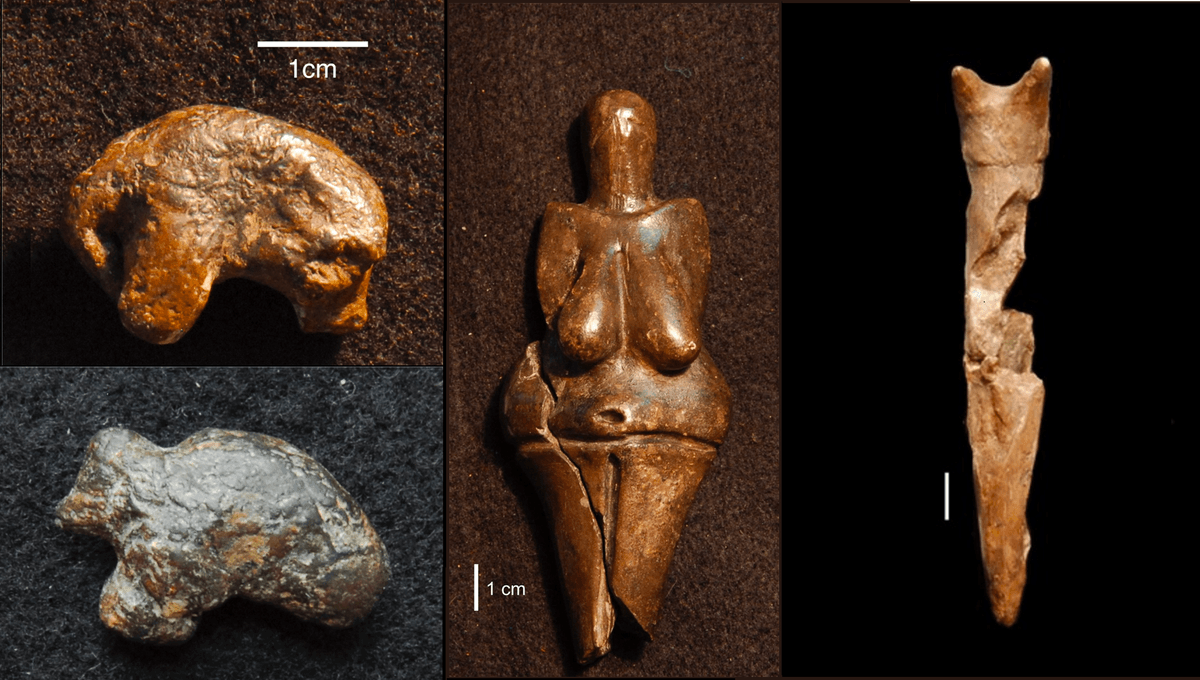
We tend to think of prehistoric life as hard. Brutal, even. Devoid of pleasure, outside of the odd mammoth steak or math class. But that dour picture tends to be missing something big – or rather, something small: kids. And, a recent study seems to suggest, they were having quite a bit of fun.
The evidence: nearly 500 ceramic artifacts, found across five archaeological sites in Czechia, dating from around 30,000 years ago – and in many cases, they were created by children.
How do we know? “[The] ceramics are smaller, more asymmetrical, and the result of simpler, shorter production sequences and techniques than artifacts made from other materials,” write Rebecca Farbstein and April Nowell, both experts on Ice Age prehistory, in their paper. “Furthermore, they demonstrate a higher degree of experimentation, techno-stylistic heterogeneity, and non-productivity.”
In other words, the ceramics, which include both human and animal figurines, are – well, they’re a bit wonky. A little weird. The product of somebody who’s not quite there yet with their craft.
“Child novices make errors in tempering, drying and firing; and they may not follow the accepted procedures, skipping a step or producing a different shape,” Farbstein and Nowell point out. “This may be because they do not completely understand what the final product should look like.”
Moreover, they note that “many figurines and figurine fragments exhibit cracks typical of thermal shock indicating that ceramics were often fired before they were sufficiently dry.”
And then there are the signatures – not left in writing, but something much more personal: “[S]ome of the Pavlovian ceramics preserve the fingerprints of the people who made them,” the authors note, “and the majority of these belong to children.”
“I think the evidence [Nowell and Farbstein] are looking at is incredibly strong, and it is a really plausible explanation for what they’re finding,” Jane Baxter, an anthropologist at DePaul University and author of The Archaeology of Childhood, told Smithsonian Magazine.
“We are trying to understand our ancestors and […] how we got here,” Baxter, who was not involved in the study, added. “These kinds of interpretations that create spaces for us to think about the fact that these were communities of people doing human activities and interacting with one another are essential.”
Indeed, the phenomenon of children using clay to create figurines is practically universal in every direction. It’s seen in archaeological finds from as far apart as Arizona and Syria; from medieval Europe to the recent history of the Ojibwe of North America; in the modern Kusasi people of Ghana, and even in our own homes – though we tend to use Play-Doh rather than real clay.
It’s not particularly surprising, then, that kids might have been doing exactly the same thing some 30,000 years ago – and, as anybody with their own mini-me can attest, neither is it strange that the figurines were left scattered about the place once the children had finished playing with them.
“[I]t looks like the kids are practicing, experimenting and playing with clay and then leaving it behind when they are done,” Nowell told Smithsonian Magazine.
“Not one piece of ceramic has been found in a burial,” the researcher pointed out, with most being found near a hearth that would have been used for firing the ceramics. “I think that what it shows us is that we’re getting the whole swath or the whole range of learning through play that goes on,” Nowell said.
It’s a new way of thinking about ancient archaeological finds – and, the authors believe, an important one. While most research into Paleolithic art has concentrated on the best-preserved or most visually striking pieces, taking a look at the more half-baked (quite literally, in this case) artifacts can reveal a picture of how societies actually functioned – even down to revealing how children played in their earliest years.
“One of the most tantalizing interpretations from this research is that Pavlovian children may have been ‘at play’ during their experiments and explorations with ceramic materials,” Nowell and Farbstein conclude. “These artifacts may, in fact, be a fortunate and rare materialization of the celebrated, and ephemeral, act of play during childhood.”
The study is published in the journal PLoS ONE.
Source Link: 30,000 Years Ago, Paleolithic Children Were Making Their Own Toys Out Of Clay